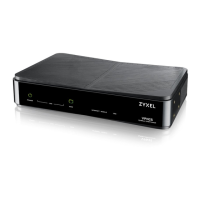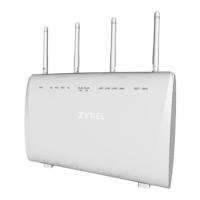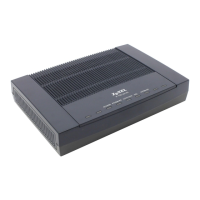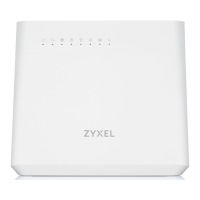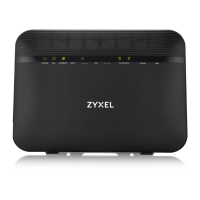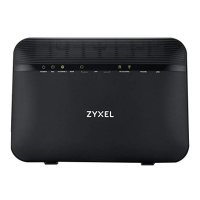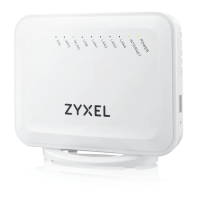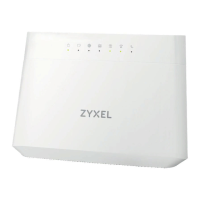Do you have a question about the ZyXEL Communications VES1724-56 and is the answer not in the manual?
Introduces the main features and applications of the Switch, including its basic introduction and hardware overview.
Provides instructions on how to install and connect the Switch, covering desktop and rack-mount scenarios.
Describes the front and rear panels of the Switch and guides on making hardware connections.
Introduces the configuration and functions of the HTML-based management interface accessible via a web browser.
Demonstrates how to set up the Switch for an example network, including IP configuration and VLAN setup.
Provides examples of using the Web Configurator to set up and use the Switch, including DHCP relay configuration.
Displays a port statistical summary with links to each port showing statistical details.
Illustrates the VDSL port status change flowchart, indicating connection states like Showtime.
Provides detailed performance data and status for an individual VDSL port on the Switch.
Displays status information for an individual VDSL port bonding group on the Switch.
Allows viewing VDSL statistics and resetting connection values.
Checks detailed transmission statistics for a selected VDSL port on the Switch.
Displays general Switch information like firmware version and hardware polling data.
Configures general settings such as system name, time, and location.
Explains Virtual Local Area Networks (VLANs) and their role in network partitioning and performance.
Configures global Switch features, including VLAN Type selection.
Introduces IPv6 addressing, its design for enhanced IP address size and features.
Configures Switch IP address, default gateway, DNS server, and management VLAN ID.
Views the status of external alarm inputs and configures their settings.
Configures Switch port settings such as speed, duplex mode, and rate limiting.
Defines ingress and egress data rate limits for the Switch port(s).
Sets hardware alarm thresholds for CPU, packet buffer, and temperature.
Views all DSL port status and details about connected CPE devices.
Configures Switch's management IPv6 addresses.
Introduces VDSL technology and its parameters, including PSD and Frequency Band Plan.
Details the eight VDSL2 frequency profiles defined in G.993.2.
Allows adding, modifying, or deleting VDSL templates, line profiles, and channel profiles.
Configures VDSL line profiles, including rate adaptive and MIB PSD mask settings.
Defines parameters for downstream and upstream transmissions for VDSL channels.
Configures G.INP settings to correct errors caused by impulse noise.
Defines control parameters for generating Equivalent INP and IAT histograms.
Defines VDSL port alarm thresholds and generates syslog entries when thresholds are exceeded.
Allows connecting subscribers to an ISP using data streams spread over multiple DSL lines.
Explains VLAN membership using explicit tags in the MAC header for frame identification.
Utilizes GARP and GVRP protocols for automatic VLAN membership registration across switches.
Enables frames belonging to unknown VLAN groups to pass through ports.
Allows selection of VLAN Type (802.1Q or Port Based) in the Switch Setup screen.
Decides whether an incoming frame on a port should be sent to a VLAN group based on its tag.
Configures and views 802.1Q VLAN parameters for the Switch.
Views, adds, modifies, and deletes VLAN profiles.
Configures static VLAN (IEEE 802.1Q) settings on a port.
Groups traffic into logical VLANs based on the source IP subnet specified.
Displays the configuration screen for subnet-based VLAN setup.
Groups traffic into logical VLANs based on the protocol specified.
Displays the configuration screen for protocol-based VLAN setup.
Provides an example of creating an IP VLAN that includes specific ports.
Groups traffic into logical VLANs based on the MAC address specified.
Details port-based VLANs where packet forwarding decisions are based on destination MAC address.
Guides on configuring port-based VLAN setup for all connected ports.
Displays frame statistics on uplink Ethernet ports for VLANs.
Discusses configuring forwarding rules based on MAC addresses of devices on your network.
Explains how to manually enter static MAC addresses for ports to reduce broadcasting needs.
Defines static multicast MAC addresses and how to forward multicast frames without joining.
Provides screens to configure rules for forwarding specific multicast frames to specific ports.
Sifts traffic going through the Switch based on source/destination MAC addresses and VLAN group.
Explains how (R)STP detects and breaks network loops, and its use of IEEE 802.1w RSTP.
Defines key terms like root bridge and path cost in spanning tree networks.
Describes how STP enables root ports and designated ports, and eliminates network loops.
Details the five port states (Disabled, Blocking, Listening, Learning, Forwarding) to prevent packet looping.
Introduces ZyXEL's proprietary MRSTP feature for multiple spanning trees on a Switch.
Explains IEEE 802.1s Multiple Spanning Tree Protocol and its features.
Displays STP status based on the chosen network standard (RSTP, MRSTP, MSTP).
Activates one of the STP modes (RSTP, MRSTP, MSTP) on the Switch.
Configures RSTP settings including bridge priority, hello time, and max age.
Displays the RSTP status screen after activating RSTP.
Configures MRSTP settings, allowing multiple spanning trees and port assignments.
Displays the MRSTP status screen after activating MRSTP.
Configures MSTP settings, including MST regions and MST instances.
Displays the MSTP status screen, showing Common Spanning Tree and MST instance details.
Limits broadcast, multicast, and DLF packets per second on ports to reduce network storms.
Configures traffic copying to a monitor port for traffic examination without interference.
Explains grouping physical ports into one logical link for higher capacity.
Adheres to IEEE 802.3ad for dynamic (LACP) port trunking, enabling negotiation and redundancy.
Displays trunk ID, enabled ports, synchronized ports, aggregator ID, and status.
Specifies the method for choosing ports in a trunk group (e.g., Source MAC Address).
Enables Link Aggregation Control Protocol (LACP) for trunk groups.
Provides an example of creating a static port trunk group for specific ports.
Validates access to ports using external servers based on username/password or MAC address.
Describes the validation process for clients connecting to IEEE 802.1x enabled ports.
Explains MAC authentication, using MAC address and password for client validation.
Activates port authentication methods and configures RADIUS server settings.
Activates IEEE 802.1x security on the Switch and individual ports.
Activates MAC authentication on the Switch and individual ports.
Allows only packets from a limited number of learned MAC addresses to pass through ports or VLANs.
Configures port or VLAN security by limiting learned MAC addresses.
Limits the number of MAC addresses dynamically learned on individual VLANs.
Introduces Quality of Service (QoS) for delivering data with minimum delay and controlling bandwidth.
Defines classifiers to sort traffic into different flows and specifies actions for matching traffic.
Provides a summary table to view classifier configurations and edit rules.
Demonstrates configuring a classifier to identify traffic from a specific MAC address on a port.
Distinguishes traffic into flows and ensures requested treatment in the network.
Explains DiffServ (Differentiated Services) for marking packets for specific per-hop treatment.
Details the DSCP field in the IP header for defining service levels and forwarding behavior.
Guides on configuring policy rules to define actions on classified traffic flows.
Shows an example of configuring a policy to limit bandwidth and discard out-of-profile traffic.
Introduces queuing methods to solve network congestion and configure algorithms for outgoing traffic.
Queues services based on priority only, transmitting traffic from the highest priority queue first.
Guarantees minimum bandwidth based on bandwidth weight, activating when ports have more traffic.
Services queues on a rotating basis based on priority and queue weight.
Configures queuing methods like SPQ, WFQ, and WRR for ports.
Allows distinguishing multiple customer VLANs within a network using outer VLAN tags.
Illustrates separating customer VLANs within a network using VLAN tags.
Defines roles for ports (Normal, Access, Tunnel) for VLAN stacking operations.
Details the format of a VLAN tag, including TPID, Priority, and VID fields.
Guides on enabling VLAN stacking on the Switch.
Lets the Switch treat all frames on a port as the same VLAN flow and add an outer VLAN tag.
Allows adding different outer VLAN tags to incoming frames based on inner VLAN tags.
Adds a customer VLAN tag to untagged incoming frames before adding the service provider's tag.
Explains IP packet transmission via Unicast, Broadcast, and Multicast, and IGMP protocol.
Describes Class D IP addresses used for sending packets to specific groups of hosts.
Controls which IGMP groups subscribers on a port can join.
Passively snoops IGMP packets to learn multicast group membership without manual configuration.
Explains IGMP snooping capabilities across VLANs in auto or fixed modes.
Enables a layer-2 switch to maintain a joined member list for IGMP groups.
Describes the MLD protocol for discovering IPv6 multicast hosts and groups.
Explains MLD messages like Report and Done for multicast forwarding table updates.
Displays multicast group information, including per-port and per-VLAN statistics.
Configures multicast group membership discovery settings like IGMP snooping and proxy.
Enables IGMP snooping on specific VLANs or automatically learns group membership.
Specifies a range of multicast IP addresses that clients can join.
Introduces Multicast VLAN Registration (MVR) for sharing multicast VLANs among subscribers.
Guides on creating multicast VLANs and selecting receiver and source ports.
Configures MVR IP multicast group addresses and associated settings.
Explains the processes of determining user identity, permissions, and recording user actions.
Describes how to store user profiles locally for authentication and authorization.
Compares RADIUS and TACACS+ security protocols for user authentication.
Guides on configuring authentication server settings and priority.
Configures RADIUS server settings, including mode, timeout, and IP address.
Configures TACACS+ server settings for authentication and accounting.
Specifies authentication methods (local, RADIUS, TACACS+) and accounting settings.
Explains Vendor Specific Attributes (VSAs) for expanding RADIUS server functionality.
Lists RADIUS attributes supported by the Switch for authentication and accounting.
Details attributes sent to RADIUS server for authentication purposes.
Uses a binding table to distinguish authorized/unauthorized DHCP and ARP packets.
Filters unauthorized DHCP packets and builds the binding table dynamically.
Defines ports as trusted or untrusted for DHCP snooping and ARP inspection.
Stores dynamic bindings for DHCP snooping and ARP inspection on an external TFTP server.
Adds information to client DHCP requests for server identification and authentication.
Steps to enable DHCP snooping, specify trusted ports, and configure DHCP relay.
Filters unauthorized ARP packets to prevent man-in-the-middle attacks.
Looks at current bindings for DHCP snooping and ARP inspection to distinguish authorized packets.
Manages static bindings for DHCP snooping and ARP inspection, identified by MAC and VLAN ID.
Displays statistics about the DHCP snooping database.
Enables DHCP snooping, specifies VLANs, and configures the DHCP snooping database.
Specifies whether ports are trusted or untrusted for DHCP snooping.
Enables DHCP snooping per VLAN and specifies DHCP relay agent option 82 information.
Displays current MAC address filters created due to unauthorized ARP packets.
Shows statistics about ARP packets received, forwarded, or discarded per VLAN.
Displays log messages generated by ARP packets that have not been sent to the syslog server.
Enables ARP inspection and configures filter aging time and log settings.
Explains how Loop Guard shuts down a port if it detects packets looping back to the Switch.
Guides on enabling loop guard on ports, noting it cannot be enabled with Spanning Tree Protocol.
Explains Connectivity Fault Management (CFM) for identifying and managing connection faults.
Describes CCMs, MEPs, MIPs, and the tests CFM uses to discover connectivity faults.
Guides on creating a Maintenance Association (MA) under an MD level.
Guides on creating a Maintenance Domain (MD) and specifying its level.
Explains how VLAN mapping enables the Switch to map VLAN IDs and priority levels.
Illustrates packets carrying VLAN ID 12 being translated to VLAN ID 123 on port 3.
Guides on enabling VLAN mapping on the Switch.
Enables and edits VLAN mapping rules.
Explains L2PT for tunneling Layer 2 STP, CDP, and VTP packets between customer switches.
Defines port modes (Access and Tunnel) for layer 2 protocol tunneling.
Guides on configuring layer 2 protocol tunneling on the Switch.
Explains how to protect against DoS attacks using filtering actions to drop packets.
Guides on configuring filtering actions to determine when to drop packets associated with DoS attacks.
Explains PPPoE Intermediate Agent (IA) for adding subscriber line info to PPPoE packets.
Details the vendor-specific tag format added to PADI and PADR packets.
Describes the formats for Agent Circuit ID and Agent Remote ID sub-options.
Divides PPPoE IA configuration into Global and VLAN screens based on service needs.
Views the PPPoE Intermediate Agent status on the Switch.
Configures telephone numbers for each port to add into PPPoE IA option 82 tags.
Configures global PPPoE IA settings applied to all PPPoE clients.
Adds extra information to PPPoE discovery packets from clients on a per-VLAN basis.
Allows connection to ADSL CPEs when VDSL connection fails, using specified ADSL standards.
Views and configures PVCs for Ethernet over ATM (EoA) packets on individual ports.
Views and configures IPPVCs for IPoA packets on individual ports.
Configures PPPoA-to-PPPoE (PAE) PVCs for PAE translation on individual ports.
Explains using IP static routes for communication with management stations and servers.
Guides on creating static routes by specifying destination IP, subnet mask, and gateway.
Introduces Quality of Service (QoS) and DiffServ as a CoS model for packet treatment.
Explains the DSCP field for defining service levels and their impact on packet forwarding.
Depicts a DiffServ network classifying incoming packets into traffic flows.
Defines traffic policing by comparing packets to CIR and PIR rates.
Applies marking rules or IEEE 802.1p priority mapping on selected ports.
Configures TRTCM settings, including color-blind and color-aware modes.
Maps DSCP values to IEEE 802.1p priority levels for traffic prioritization.
Explains DHCP for obtaining TCP/IP configuration and configuring the Switch as a relay agent.
Describes modes for configuring the Switch as a DHCP relay agent.
Divides DHCP configuration into Global and VLAN screens for offering services to clients.
Displays the DHCP status, including relay mode and remote DHCP server information.
Configures telephone numbers for each port, potentially adding them to DHCP option 82 tags.
Explains configuring DHCP relay for clients and servers not in the same broadcast domain.
Describes adding information to DHCP requests for server authentication.
Details the format of the DHCP Relay Agent Information option (Option 82).
Explains the formats for Agent Circuit ID and Agent Remote ID sub-options.
Enables DHCP snooping, trusted/untrusted ports, and DHCP packet rate limits.
Provides a network example of the Switch relaying DHCP requests for VLAN1 and VLAN2.
Configures DHCP settings based on the VLAN domain of DHCP clients.
Adds information to client DHCPv6 requests for server authentication.
Displays DHCPv6 packet statistics.
Configures acceptable rates for receiving DHCPv6 packets on each port.
Manages firmware and configuration files, including upgrade, backup, and restore options.
Guides on upgrading the Switch firmware, emphasizing using the correct model firmware.
Restores a previously saved configuration from a computer to the Switch.
Creates snap shots of the Switch configuration for later restoration.
Resets the Switch back to factory defaults, with an option to keep current IP settings.
Saves current configuration settings permanently to Configuration 1 or Configuration 2.
Restarts the Switch without physically turning off power, allowing loading of saved configurations.
Provides examples of uploading/downloading files using FTP commands and filename conventions.
Describes controlling access to the Switch via console, Telnet, SSH, Web, and SNMP.
Displays the main screen for managing access control features like SNMP and logins.
Introduces SNMP as a protocol for managing and monitoring network devices.
Explains how SNMP v3 enhances security through authentication and encryption.
Lists the Management Information Bases (MIBs) supported by the Switch for statistics and monitoring.
Details the SNMP traps sent by the Switch to an SNMP manager when an event occurs.
Specifies the types of SNMP traps to be sent to each SNMP manager.
Describes configuring user accounts for accessing the Switch via the Web Configurator.
Introduces SSH as a secure protocol for encrypted communication between hosts.
Summarizes how a secure connection is established between two remote hosts using SSH.
Details the Switch's support for SSH version 2 and its encryption methods.
Explains HTTPS as a web protocol for secure transactions using SSL.
Provides instructions for accessing the Switch via HTTPS, including browser warnings.
Decides which services can be used to access the Switch and configures trusted computers.
Specifies groups of trusted computers for administrator access to manage the Switch.
Checks system logs, pings IP addresses, and performs port tests.
Explains the syslog protocol for sending event notification messages to syslog servers.
Configures syslog settings to send logs to an external syslog server.
Configures a list of external syslog servers and specifies log severity levels.
Performs dual-end loop tests on ports to check status and test results.
Checks the distance to the subscriber's location and performs loopback tests.
Shows how frames are forwarded or filtered across Switch ports based on MAC addresses.
Displays the MAC table, allowing sorting and clearing of learned MAC addresses.
Explains ARP for mapping IP addresses to MAC addresses in an Ethernet LAN.
Describes the process of ARP broadcasts and table updates for device resolution.
Allows viewing IP-to-MAC address mappings in the ARP table.
Checks detailed hardware information like CPU, packet buffer, and memory utilization.
Manages connectivity faults by performing Continuity Check, Link Trace, and Loop Back tests.
Describes IPv6 caches and the Neighbor Discovery Protocol (NDP) for device discovery.
Views link-layer addresses of Switch interfaces and neighboring devices, and their reachability.
Views IPv6 router advertisement information, including hop limit and prefix details.
Checks IPv6 path MTU sizes and expiration information for data transmissions.
Troubleshoots power issues, hardware connections, and LED behaviors.
Provides solutions for forgotten IP addresses, usernames, passwords, and login screen access issues.
Addresses issues related to lost configuration settings after restarting the Switch.
Summarizes the Switch's hardware features, including default IP, admin credentials, and interfaces.
Lists the standards supported by the Switch, including RFCs and IEEE protocols.
Lists commonly used services, their protocols, port numbers, and descriptions.
States the copyright and publication details for the document.
Disclaims liability for application or use of products and reserves the right to make changes.
Lists ZyNOS and other trademarks used for identification.
Provides information on FCC and CE certifications.
Warns about CE Mark and potential radio interference in domestic environments.
Guides on how to view product certifications on the ZyXEL website.
Details the warranty terms, covering defects in materials or workmanship for up to two years.
| Model | VES1724-56 |
|---|---|
| Switching Capacity | 56 Gbps |
| Power over Ethernet (PoE) | No |
| Storage Temperature | -40°C to 70°C |
| Ports | 24 x 10/100/1000Base-T RJ-45 VDSL2 ports |
| Forwarding Rate | 41.67 Mpps |
| MAC Address Table | 8K entries |
| Jumbo Frame Support | 9K bytes |
| Dimensions | 440 mm x 280 mm x 44 mm |
| Operating Temperature | 0°C to 40°C |
| Humidity | 10% to 90% (non-condensing) |
